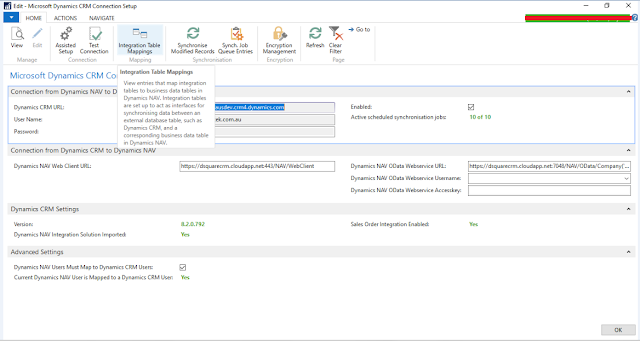In my post, you will get to know how to integrate CRM with Navision 2017.
Prerequisite for CRM-
You would need an instance of CRM. If you dont have it you can click on the link and create one. https://www.microsoft.com/en-us/dynamics/free-crm-trial.aspx
Note- All my development and testing have done in Azure server.
Prerequisite for Nav- make sure all the CRM objects in Navision 2017 are the version of NAVW110.00.00.14199, that is of cumulative update 2, otherwise you get errors.
Follow the following Steps-
1.Go to CRM
homepage, in the homepage go to Settings\Customizations
and click on Solutions.
2. Import a solution
in CRM by clicking the import button and browse the zip file which is available
in NAVDVD\CrmCustomization.
3. Click Next and Import the solution.
4. Now, under settings Go to Security and click on Users.
5. We need Two users in CRM to perform integration with NAV, One would be the admin of CRM and the other would be the Integration User. Here I’m using the same User for admin and Integration User.
6. You have to assign 4 roles to this user- dynamics Nav integration administrator, dynamics Nav integration User, system administrator, system customizer.
7. There is a field on this user’s form, Integration user mode, make sure it is YES.
8. In the search bar in Navision 2017 type CRM Connection Setup and open the page or go to Departments/Administration/IT Administration/Services and click on Microsoft CRM connection setup.
9. Click on assisted setup and enter Dynamics CRM URL and in the next window enter the Credentials. Here I’m using the same user for integration and admin.
10. Click Next and finish the assisted setup, make sure every Boolean field is true.
13. To map the Dynamics NAV user to CRM user, Go to the user and fill in the office 365 authentication Email ID.
14. To check all the standard mapping, click on Integration Table mappings.
15. This is standard table to table mappings in Navision 2017 to CRM.
16. Now to check further, click on fields to check field to field level mappings.
17. Here as you can see, the last three fields have been added by me, this is custom mappings.
18. In my next post, I will show you how to map
these custom fields in different CRM entities.














Nice post..!
ReplyDeleteThank you Sir :D
DeleteGreat Post!! Thanks for sharing this with us.
ReplyDeleteCRM System
Hi, thanks for this post.
ReplyDeleteI have tried to integrate NAV 2016 On-Premise and Dynamics 365 (8.2.2.160).
I followed same way. I get error "Invalid ISO Currency Code" when coupling NAV Items and CRM Product. Also, i coupled successfully CRM Transaction Currency and NAV Currency.
Also, i can't see Integration Field Mapping button.
I appreciate if you can help.
Your article is very useful for me. Thank you for sharing this useful information.
ReplyDeleteMicrosoft Dynamics CRM Training Courses | Microsoft Dynamics CRM Training Institutes in Chennai
This concept is a good way to enhance the knowledge.thanks for sharing. please keep it up Salesforce Online Training Hyderabad
ReplyDeleteGreat articles, first of all Thanks for writing such lovely Post!
ReplyDeletetechnocrawler
Technology
ReplyDeleteI would definitely thank the admin of this blog for sharing this information with us. Waiting for more updates from this blog admin.
Tally Course in Chennai
ReactJS Training in Chennai
microsoft dynamics crm training in chennai
ui design course in chennai
microsoft dynamics training
gst training classes in chennai
nice blog. thanks for sharing Devops Tutorials. It’s really Helpful for me.
ReplyDeleteMicrosoft Dynamics Online Training